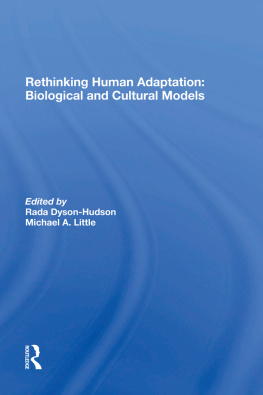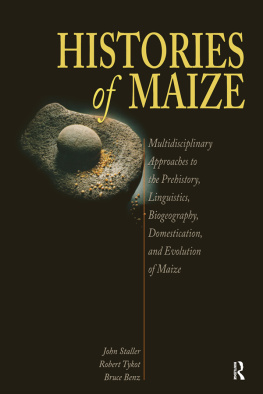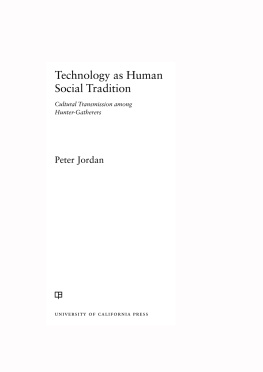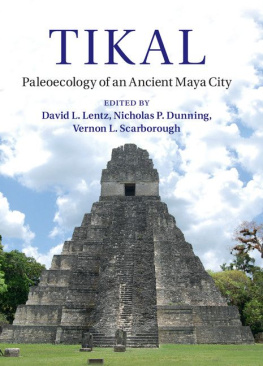Human Adaptation in Ancient Mesoamerica
Human Adaptation in Ancient Mesoamerica
Empirical Approaches to Mesoamerican Archaeology
Edited by Nancy Gonlin and Kirk D. French
University Press of Colorado
Boulder
2016 by University Press of Colorado
Published by University Press of Colorado
5589 Arapahoe Avenue, Suite 206C
Boulder, Colorado 80303
All rights reserved
Printed in the United States of America

The University Press of Colorado is a proud member of Association of American University Presses.
The University Press of Colorado is a cooperative publishing enterprise supported, in part, by Adams State University, Colorado State University, Fort Lewis College, Metropolitan State University of Denver, Regis University, University of Colorado, University of Northern Colorado, Utah State University, and Western State Colorado University.
This paper meets the requirements of the ANSI/NISO Z39.48-1992 (Permanence of Paper).
ISBN: 978-1-60732-391-4 (cloth)
ISBN: 978-1-60732-392-1 (e-book)
The University Press of Colorado gratefully acknowledges the generous support of The Pennsylvania State University toward the publication of this book.
Library of Congress Cataloging-in-Publication Data
Human adaptation in ancient Mesoamerica / edited by Nancy Gonlin and Kirk D. French.
pages cm
Includes bibliographical references.
ISBN 978-1-60732-391-4 (cloth : alkaline paper) ISBN 978-1-60732-392-1 (ebook)
1. MayasSocial conditions. 2. MayasAntiquities. 3. Human ecologyMexicoHistoryTo 1500. 4. Human ecologyCentral AmericaHistoryTo 1500. 5. Social archaeologyMexico. 6. Social archaeologyCentral America. 7. Environmental archaeologyMexico. 8. Environmental archaeologyCentral America. 9. MexicoAntiquities. 10. Central AmericaAntiquities. I. Gonlin, Nancy. II. French, Kirk D.
F1435.3.S68H86 2015
972.81'01dc23
2014050139
25 24 23 22 21 20 19 18 17 16 10 9 8 7 6 5 4 3 2 1
Cover photograph: Dr. David Webster and Don Santos Rosa confer on the next steps in excavating the corner of Structures 9N-82 (House of the Bacabs) and 9N-83 at Copan, Honduras, in the ancient neighborhood of Las Sepulturas (photo by Elliot Abrams, December 1980).
To David Webster
Extraordinary anthropologist,
exceptional archaeologist,
inspiring mentor, life-long friend
Contents
George R. Milner
Nancy Gonlin and Kirk D. French
Kirk D. French and Nancy Gonlin
Susan Toby Evans and Deborah L. Nichols
Kirk D. French and Christopher J. Duffy
John D. Wingard
AnnCorinne Freter and Elliot M. Abrams
Stephen L. Whittington and Nancy Gonlin
Randolph J. Widmer and Rebecca Storey
David M. Reed and W. Scott Zeleznik
Zachary Nelson
Kirk Damon Straight
Don S. Rice and Prudence M. Rice
David Webster
Foreword
GEORGE R. MILNER
When asked to write an introductory piece, I was not entirely sure what could possibly be added to this already fine collection of essays. The editors provided few instructions, other than that as head of Penn States anthropology department I should say something about the archaeology program, and as one of David Websters colleagues for upwards of 30 years it would be appropriate to highlight some of his contributions to archaeology.
So I suppose the title of Davids chapter, Two Katun Archaeologist, is as good a place to start as any. While appropriately enough referring to the Maya, it has been my experience that he is more interested in the Great Game and the other happenings, preoccupations, and follies of imperialism, which serve as fine examples of how institutions work (or dont), and the often serendipitous unfolding of human history that, more often than not, is little more than one misadventure after another. At least that is what we are forever talking about in his office or mine, although that might just reflect my tenuous grasp of Mesoamerican prehistory. But it also underscores Davids wide, almost encyclopedic, knowledge of human affairs, institutions, and history (extending into deep prehistory) derived from extensive reading, travel, and reflection.
To establish my credentials for the task at hand, I should trot out my sole entry into the vast, thought-provoking, and provocative, if not always believable, Mesoamerican literature ( Buikstra et al. 2006 ). David had a hand in this work, if only as an interested bystander. A number of years ago when Jesper L. Boldsen (University of Southern Denmark) and I were developing a better means of skeletal age estimation for adults, my former doctoral advisor, Jane E. Buikstra, contacted me because she was heading off to Palenque to look at a skeleton. In due course she sent me her observations of the pubic symphysis, the best part of the skeleton for aging purposes, along with a photograph. When I received them, I had no idea that a controversy swirled around this skeletons age and identity. It just so happened that David walked by my office shortly after Jesper and I calculated the individuals age, which took work on both sides of the Atlantic. When told about the result, David reacted with surprise and pleasure because the maximum likelihood estimate was within a few years of the glyph-derived age, which, until our conversation, was unknown to me. He also explained who the mysterious Pakal was, and that archaeologists were divided over whether the skeleton was his or not.
This was one of those rare occasions when a single result clearly distinguishes among competing ideas. There were several alternatives that, to an outsider like myself, might be possible, if not equally plausible: the original skeletal age estimates were wide of the mark, somebody elses body was placed in Pakals tomb, the glyph age was deliberately misleading, or the glyph age was mistranslated. As it turns out, the individual buried in the tomb was indeed an old man, so existing age estimates were in error, as they were too young. That comes as no surprise because standard procedures produce biased results, so the true ages of people from roughly their fifties onward are underestimated. In addition, they fail to provide a means of doing anything with individuals thought to be old, other than lumping them into a terminal, open-ended interval (e.g., 50+ years). So perhaps the skeleton really was Pakal. Going that far, however, rests squarely on the consistency of all available evidence: the age and sex of the skeleton, burial offerings, tomb characteristics and location, and glyphs. In this instance, the data are mutually supportive and point in one direction, meaning we can be reasonably happy with the interpretation.
The last point will strike a chord with anyone who knows David. He is always saying that the best inferences are those that are based on multiple lines of evidence. Claims that new findings overturn long-established interpretations are common in our field. Sometimes that actually is the case, which is gratifying because present understandings should always be questioned in light of additional information and improved methods. Unfortunately, new findings that supposedly have revolutionary implications are often found wanting upon further reflection. That is because of technical problems, which were not initially fully understood, or poor sampling, especially the number and representativeness of the materials examined.










 The University Press of Colorado is a proud member of Association of American University Presses.
The University Press of Colorado is a proud member of Association of American University Presses.